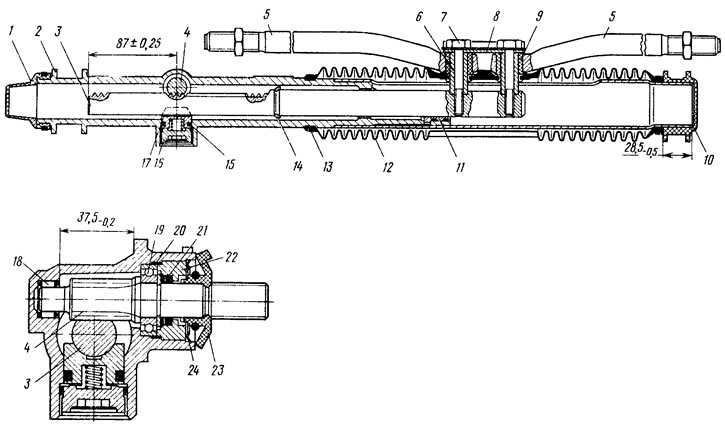The support sleeve 2 is installed in the crankcase, making sure that its cutouts fit into the crankcase holes. Before inserting the support sleeve into the crankcase, sealing rings 1 are installed in its grooves so that the thin part of the rings is opposite the sleeve cut. After installing the support sleeve in the crankcase, the rings are cut along the contour of the sleeve, removing the cut off parts.
Having generously lubricated the teeth of the rack with Fiol-1 grease, and its other surfaces with a thin layer of the same grease, install the rack into the crankcase by sliding it through the support sleeve 11 (pic. 103) against the stop in a special fixture to withstand the size (87±0,25) mm from the end of the rail to the axis of the rail stop.

Pic. 103. Steering gear: 1 - protective cap; 2 - steering gear housing; 3 - rail; 4 - drive gear; 5 - tie rod; 6 - spacer sleeve; 7 - a bolt of fastening of steering draft; 8 - connecting plate; 9 - thrust sleeve; 10 - support of the steering mechanism; 11 - rail support sleeve; 12 - protective cover; 13 - collar; 14 - thrust ring of the rack; 15 - sealing ring of the rail stop; 16 - nut; 17 - rail stop; 18 - roller bearing; 19 - ball bearing; 20 - retaining ring; 21 - sealing ring of the nut; 22 - gear bearing fastening nut; 23 - anther; 24 - puck
Apply Fiol-1 grease to the teeth of the drive gear and put Fiol-1 grease into the ball bearing until it appears on the upper end of the bearing. Then install the gear in the crankcase so that the flat on its shaft is facing to the right (along the car) and press the bearing into the crankcase until it stops. The maximum pressing force of the bearing is 152.9 kgf. The total amount of grease for the rack, drive gear and bearing should be 20-30 g.
Wrench 67.7812.9536 tighten the drive gear nut to the torque (5±0,5) kgf-m, install retaining ring 11 (see fig. 102) and fill the cavity above the nut with Uniol-1 grease.
Install the drive gear in the position of the rectilinear movement of the car, which is determined by size (87±0,25) mm in fig. 103. Then mandrel 67.7853.9586 (inner diameter 18 mm, outer diameter 24 mm) press the anther 23 onto the gear shaft so that marks A and B (see fig. 101) on the anther and on the crankcase coincided, and the anther fit snugly against the end of the crankcase.
Install the movable stop 15 (see fig. 102) rails with a sealing ring 16 until it stops against the rail (to the pointless state). Install the compression spring, retaining ring 17 and tighten the nut 18 with a wrench 67.7812.9537 to a torque of 1.1-1.3 kgf-m, then loosen the nut by two divisions (24), to provide a gap of up to 0.12 mm between the nut and the rail stop, necessary to compensate for the thermal expansion of parts and inaccuracies in their manufacture. The moment of loosening the nut must be at least 0.45 kgf-m.
After that, they make sure that the moment of rotation of the gear in the region of the entire stroke lies in the range of 6-17 kgf-cm at a rotation frequency of 30 rpm. If the gear torque is not within the specified limits, identify and eliminate the causes of seizing parts, paying special attention to the rack stop, drive gear and rack. After that, the stop nut 18 is screwed in at two opposite points. The position of the nut is marked with paint for control.
Reinstall protective cover 12 (see fig. 103) so that its right end is at a distance of 28.5-0,5 mm from the end of the pipe and fix it with clamps. Then install the support 10 so that it fits snugly against the cover. Attach the tie rods to the rack. Bolts 7 for fastening the rods are tightened with a torque (7,8±0,8) kgf-m and lock them by bending the edges of the locking plate onto the edge of the bolts.
After assembly, make sure that the protective cover, when the rack is moved at a gear rotation speed of 30 rpm, does not have bulges and pinches, and the gear rotation torque in the entire stroke area is still within 6–17 kgf-cm at a rotation speed of 30 rpm min. Otherwise, the causes of the identified defects are eliminated. The torque of the gear is checked with a dynamometer 02.7812.9501 with an adapter sleeve 67.7812.9540. It is re-confirmed that if the marks on the anther and on the steering gear case coincide, the distance from the end of the rack to the axis of the drive gear is equal to (87±0,25) mm.
